Wieder kein Sieg. Der FC St. Pauli tritt nach dem Unentschieden gegen den SC Paderborn auf der Stelle. Trotz zweimaliger Führung konnte nicht gewonnen werden. Denn ein sehr guter Gegner legte die aktuellen Problemzonen des FCSP ziemlich schonungslos offen. Die Tabellensituation ist weiter gut, aber die aktuelle Form eher ernüchternd – es wartet viel Arbeit auf den FC St. Pauli.
(Titelbild: Peter Böhmer)
Die Aufstellung
Maximilian Dittgen startete etwas überraschend als zweite Spitze neben Guido Burgstaller. Zudem kam im Vergleich zum Spiel gegen den HSV Luca Zander auf der rechten Abwehrseite für Sebastian Ohlsson ins Spiel. Die Probleme von Ohlsson sind etwas schlimmer, als zunächst angenommen. Er stand nicht einmal im Kader. Timo Schultz sagte auf der Pressekonferenz nach dem Spiel, er hoffe, dass Ohlsson nächste Woche wieder ins Training einsteigen kann.
Auch in der Innenverteidigung gab es einen personellen Wechsel: Philipp Ziereis kam anstelle von James Lawrence ins Spiel und hatte mit einem etatmäßigen Abwehrspieler der Gegner gut zu tun.
Abwehrspieler? Ja, beim SC Paderborn gab es dann doch eine recht große Überraschung in der Aufstellung. Denn weder Felix Platte, noch Neuzgang Kemal Ademi (nicht im Kader) und auch nicht Dennis Srbeny starteten in vorderster Reihe. Stattdessen war es Jannis Heuer, der auf ungewohnter Position startete. SCP-Trainer Lukas Kwasniok wollte sich die Körperlichkeit von Heuer zunutze machen. Es war eine gute Idee.
Einen weiteren personellen Wechsel im Vergleich zur Niederlage gegen Werder Bremen vor zwei Wochen gab es noch: Robin Yalcin kam für den zu Union Berlin abgewanderten Sven Michel ins Spiel.
Beide Teams ordneten sich in einem 4-4-2 mit Raute in der Grundformation an. Im Laufe des Spiels veränderte der FCSP die Formation ein wenig. Der SC Paderborn interpretierte diese Grundformation gewohnt flexibel, sodass es zwischendurch mehr nach einer Art 4-2-3-1 aussah und in der zweiten Halbzeit nach einem 4-2-2-2.
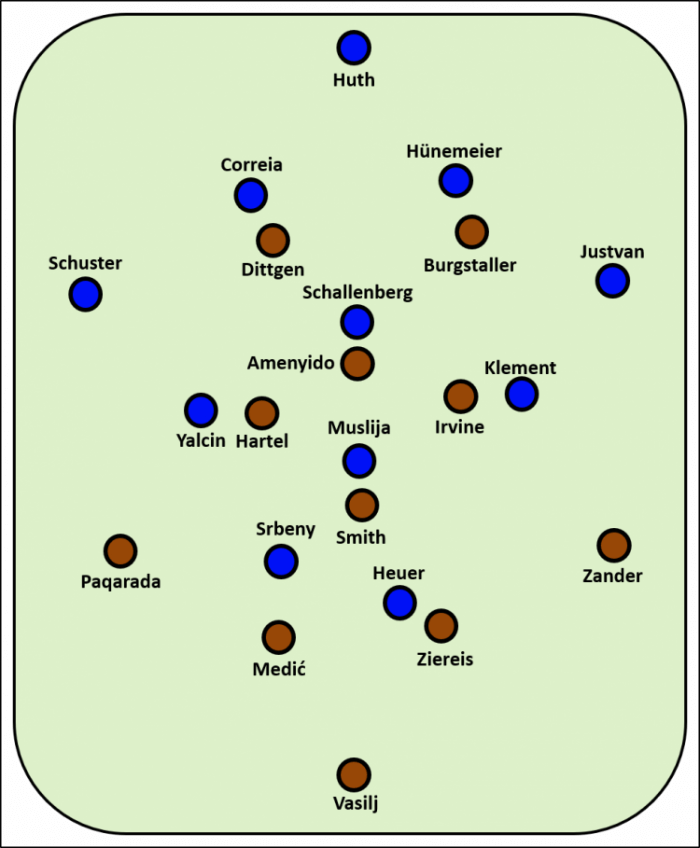
Back to the Roots!
Im Gegensatz zu den letzten beiden Spielen, als der FC St. Pauli defensiv in einem flachen 4-4-2 verteidigte, kehrte das Team bei gegnerischem Ballbesitz wieder zu einem 4-4-2 mit Raute zurück. Etienne Amenyido, der auf der Zehner-Position spielte, agierte dabei meist mannorientiert auf Paderborns Kapitän Ron Schallenberg, bewegte sich aber auch ganz gut im Raum.
Bevor das Spiel so richtig startete, stand es auch bereits 1:0. Der FC St. Pauli kehrte also nicht nur mit seiner Formation wieder zurück zu seinen Wurzeln, sondern erzielte auch mal wieder eine ganz frühe Führung am Millerntor. Nachdem Amenyido mit einem Pass vorbei an vielen, vielen Gegenspielern stark von Paqarada in Szene gesetzt wurde, zeigte Maximilian Dittgen, dass er sich im Strafraum klug zu bewegen weiß und drehte sich sehr gut nach dem Anspiel von Amenyido aus dem Verteidiger raus – 1:0, Start nach Maß.

(Joern Pollex/Getty Images/via OneFootball)
Aufbau FC St. Pauli: Toter Raum, wo Spielkultur sein soll
In der Folge entwickelte sich aber ein zunehmend schwieriger werdendes Spiel für den FC St. Pauli. Denn der SC Paderborn zeigte sich sehr gut auf das Aufbauspiel des FC St. Pauli eingestellt:
Bei Ballbesitz FCSP ließ sich Yalcin häufig in den Sechserraum neben Schallenberg fallen. Seine Position im rechten offensiven Halbraum nahm Srbeny ein, der dabei sehr mannorientiert auf Leart Paqarada agierte. Das ist nun inzwischen auch schon gut gelebte Praxis der Gegner des FC St. Pauli, dass sie sich in vorderster Reihe im Defensivverhalten vor allem auf St. Paulis Linksverteidiger fokussieren. Paqarada ist einfach sehr spielstark und hatte bis in den Spätherbst hinein eigentlich immer viel zu viel Raum im Aufbauspiel bekommen. Nun haben aber viele Gegner genau dieses linkslastige Aufbauspiel gut im Blick und stören Paqarada meist sehr früh. Darauf sucht der FC St. Pauli seit einigen Spielen Antworten.
Eine Antwort ist das Verhalten der beiden Achter in der Mittelfeldraute. Marcel Hartel agierte sehr häufig im Sechser-Raum neben Eric Smith, um dort bessere Verbindungen anzubieten. Auf der Gegenseite schob Jackson Irvine häufig auf die Höhe von Amenyido, sodass aus der Raute ein Quadrat wurde.
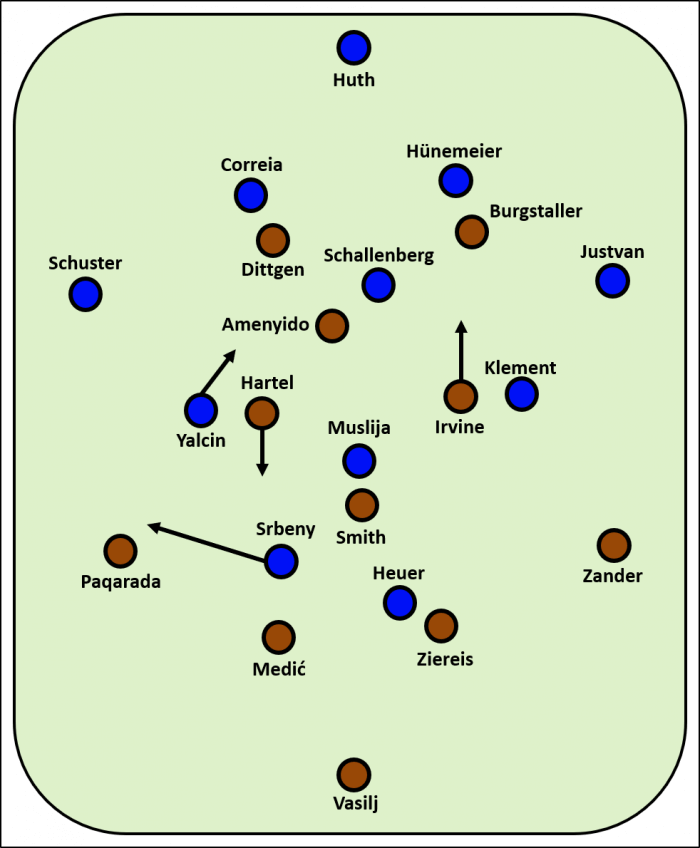
Es war sehr auffällig, dass dieses Aufbauspiel nicht so richtig gut funktionierte. Die Positionierung mit Hartel und Smith war dabei nicht unbedingt das Problem. Vielmehr schaffte es der FC St. Pauli viel zu selten, die Verbindungen nach vorne zu erstellen. Es war fast, als hätte sich da eine imaginäre Mauer aufgebaut, welche die vorderen vier Spieler von den hinteren sechs zu trennen schien. Das Gegenbeispiel war das 1:0, als Paqarada einen fantastischen Ball zu Amenyido in den Zehnerraum spielte. Grund für diese „Mauer“ waren viele ungenaue Anspiele, die ziemlich untypisch für das Spiel des FC St. Pauli sind bzw. im Herbst 2021 waren. Aber es war auch ein strukturelles Problem: Der Spielaufbau des FC St. Pauli ist schlicht zu statisch gewesen.
Beispielhaft lässt sich das leider ziemlich gut an Jackson Irvine festmachen. Der schob bei Ballbesitz, wie eigentlich immer, recht weit hoch und ist dadurch sehr wenig am Aufbauspiel beteiligt. Aus meiner Sicht nahm er sich durch diese Bewegungen aber zuletzt mehr und mehr Aktionsspielraum. Würde er aus dieser hohen Positionierung immer wieder partiell tiefer fallen, um sich für Anspiele zu empfehlen, könnte es dem FC St. Pauli vielleicht besser gelingen, Verbindungen zu erschaffen. Aber das tat Irvine nicht. Da Paderborn mit Yalcin und Schallenberg mit einer Art Doppel-Sechs defensiv agierte, nahmen sie Irvine und Amenyido sehr gut auf. So war genau der Raum, den der FC St. Pauli eigentlich öffnen möchte, meist unerreichbar. Und Irvine und Amenyido dann entsprechend auch.
Aufbau SC Paderborn: Zentrum dicht? So what!
So richtig in Fahrt kam der SC Paderborn in der ersten Halbzeit auch nicht. Trotzdem war da bereits zu erkennen, dass sie mit der Mittelfeldraute des FC St. Pauli ganz gut umgehen können. „Umgehen“ ist dabei sogar genau das richtige Stichwort, denn das passierte ständig auf dem Platz. Bei Ballbesitz schoben Yalcin und Muslija immer weit nach außen und gaben dem Spiel des SCP damit die notwendige Breite. Das ist eigentlich die einzig sinnvolle Vorgehensweise, wenn ein gegnerisches Team das Zentrum dichtmacht. Ziel ist es dann durch schnelle Verlagerungen Räume zu öffnen, denn die Raute schiebt immer recht kompakt auf eine Seite und gibt den ballfernen Raum frei. Dem FC St. Pauli gelang es in dieser Saison sehr häufig, den Gegner dabei auf einer Seite zu halten, wenn dieser im Ballbesitz war. Entsprechend war die verwaiste ballferne Seite nie ein großes Problem. Gestern wurde es eines.
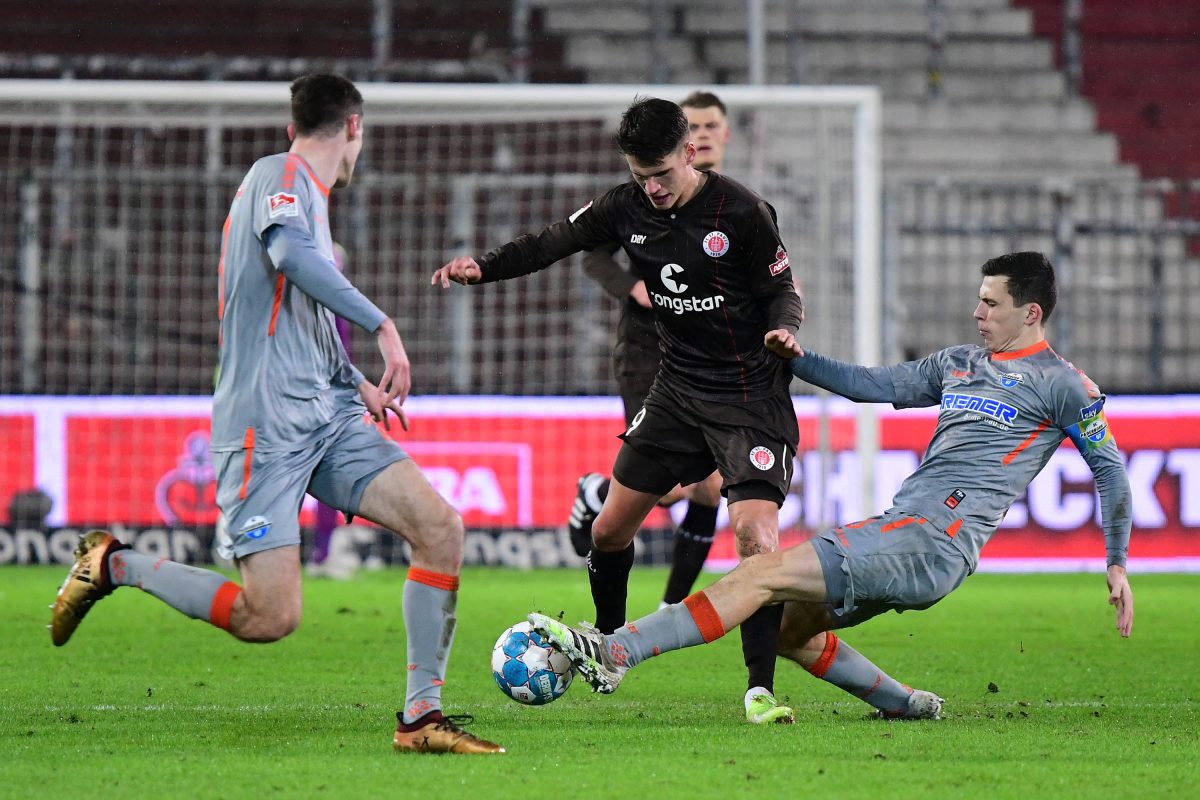
(c) Peter Böhmer
Dem SC Paderborn gelangen diese schnellen Verlagerungen immer häufiger, je länger das Spiel dauerte. Meist waren es Philipp Klement oder der unfassbar spielstarke Julian Justvan, die diese Verlagerungen initiierten. Ich hebe ja immer gerne hervor, wie spielstark Leart Paqarada auf der linken Abwehrseite ist, aber Justvan ist dann doch noch mal ne ganze Ecke stärker (wobei er nominell auch eher ein Zehner/Achter ist). Justvan hat unter Kwasniok irgendwie diese neue Rolle bekommen und diese füllt er richtig gut aus.
Es ist dann auch genau eine solche Verlagerung gewesen (wenngleich nicht über Klement oder Justvan), die zum Ausgleich führte: Srbeny und Schallenberg schafften es aus dem Pressing des FCSP heraus auf links zu verlagern. Dort hatten Justvan und Muslija bereits die Seite überladen, sodass erstmal Rückwärtsgang beim FCSP angesagt war. Heuer zog mit Tempo ebenfalls auf die linke Seite, Ziereis ging mit, Srbeny lief in den Raum von Ziereis, Medić nicht – 1:1.
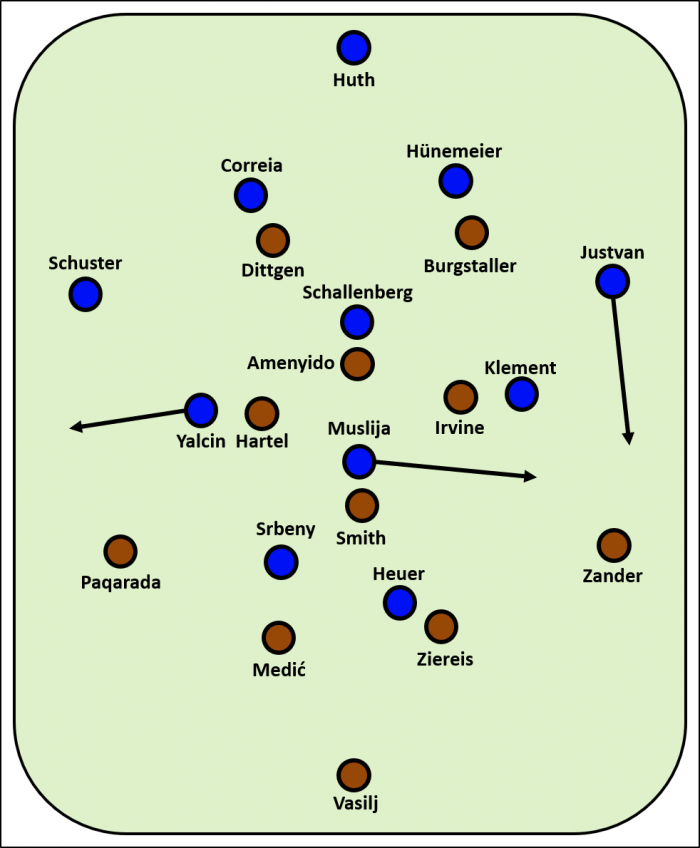
Es war also nicht das erwartete schnelle Umschaltspiel der Paderborner nach Ballgewinn, welches für den FC St. Pauli zum Problem wurde. Stattdessen zeigte sich, dass sich ihr Spiel durch den Abgang von Sven Michel (der hauptverantwortlich für das starke Umschaltspiel war) und die Neuzgänge Klement und Muslija massiv verändert hat. Der SCP scheint nun ein spieldominantes Team zu sein.
Trotzdem gab es auch immer wieder Umschaltmomente, die gefährlich wurden für den FC St. Pauli, da der erste Blick der Paderborner Spieler bei Ballgewinn immer der Option eines schnellen, tiefen Passes galt (vor allem Justvan hat da einige richtige starke Pässe in die Spitze gespielt).
Natürlich ist dieses Umschaltspiel des SC Paderborn hervorhebenswert, aber kurz vor der Halbzeit zeigte der FC St. Pauli, dass sie das auch richtig, richtig gut können: Im Spielaufbau schaffte es der SC Paderborn mal nicht in die Verlagerung, sondern verhedderte sich auf der rechten Außenbahn im Pressing des FC St. Pauli. Sieben Sekunden nach dem Ballverlust lag der Ball im Tor.
Es mag einiges gehapert haben im Spiel des FC St. Pauli. Aber zur Halbzeit führten sie dann mit 2:1, weil sie in zwei Momenten genau das zeigten, was sonst zu oft fehlte: Beim 1:0 schaffte es Paqarada den Zehnerraum zu erreichen und beim 2:1 schaltete das Team traumwandlerisch um – trotz einer für den FCSP eher mittelmäßigen Halbzeit reichten diese zwei Momente, um gegen einen starken Gegner zu führen. Bei aller Kritik an der Leistung müssen wir festhalten, dass dies das Level ist, über das wir uns unterhalten.

(Joern Pollex/Getty Images/via OneFootball)
2. Halbzeit: Paderborn verfeinert, St. Pauli wankt
SCP-Trainer Lukas Kwasniok sagte auf der Pressekonferenz nach dem Spiel, dass sein Team zur zweiten Halbzeit auf „die Doppelsechs des FC St. Pauli reagiert“ habe, er zählte Hartel sogar eher als Sechser. Mit der Einwechslung von Thalhammer wurde im Mittelfeld umgestellt, wodurch die Zuordnung etwas angepasst wurde. Srbeny agierte nun eher als zweite Spitze und dahinter bildeten Muslija und Klement ein Duo, welches Hartel und Smith besser aufnahm. Noch eine Reihe dahinter bildeten Schallenberg und Thalhammer nun die Doppelsechs (Yalcin wechselte auf die Rechtsverteidiger-Position). Das beschriebene Quadrat des FC St. Pauli im Spielaufbau, es bekam in der 2. Halbzeit also ein passendes Paderborner Gegenstück. Entsprechend würde ich das als 4-2-2-2 bezeichnen, was der SCP da gespielt hat.
Der FC St. Pauli bekam nun mehr und mehr Probleme mit dem Paderborner Offensivspiel. Timo Schultz sagte auf der PK, dass das Aufbauspiel seines Team in der 1. Halbzeit ganz okay geklappt habe, aber die vielen Ungenauigkeiten in Form von Ballverlusten ein Problem gewesen seien. Mit der 2. Halbzeit war er deutlich weniger zufrieden, denn das Freilaufverhalten sei nicht mehr so gut gewesen, auch deshalb, da sein Team aufgrund der Führung nicht mehr so sehr ins Risiko ging.
Es war definitiv ein Problem, dass der Ball einfach viel zu schnell wieder in Paderborner Füße wanderte. Auch die Umschaltmomente von Paderborn wurden gefährlicher, aber vielmehr war es ein Problem, dass Paderborn nahezu ungestört in die Verlagerungen kam, da der FCSP sich viel zu tief in die eigene Hälfte drängen ließ.
Timo Schultz reagierte bereits zum Start der zweiten Halbzeit mit stärkerer Mannorientierung, doch das half nicht sonderlich viel. Der SC Paderborn war klar dominant und erspielte sich erheblich mehr Torchancen, als noch in der ersten Hälfte.
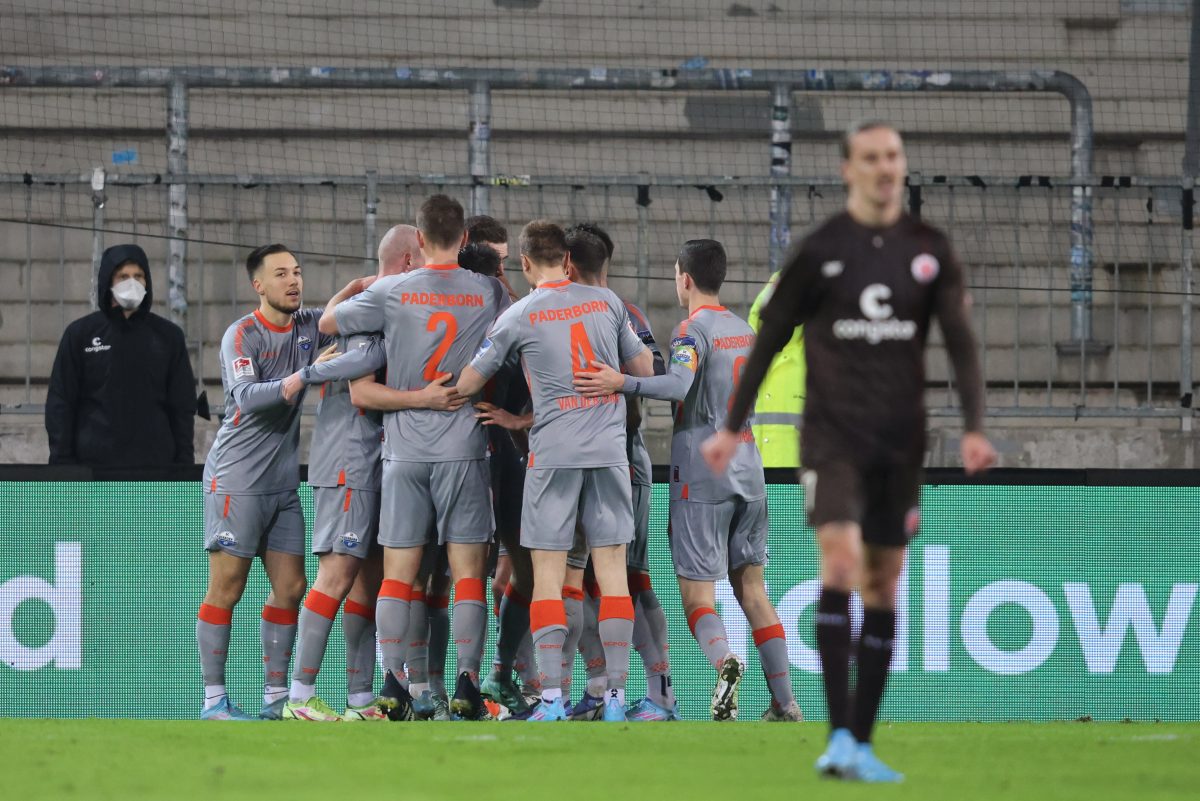
(Joern Pollex/Getty Images/via OneFootball)
Mit der Einwechslung von Finn Ole Becker in der 63. Minute folgte dann eine Umstellung der Formation: Fortan agierte der FC St. Pauli wieder in einem flachen 4-4-2, also mit zwei Viererketten. Laut Schultz versuchte das Team damit die Breite etwas besser abzudecken, da dies mit der angepassten Mannorientierung nicht richtig funktionierte. Es klappte aber auch mit der Umstellung nicht so viel besser.
Was auch nicht gut klappte, waren die eigenen Umschaltmomente. Denn so gut der SC Paderborn auch nach vorne spielte, so löchrig sah dann auch einige Male deren Restverteidigung aus. Gerade ab Mitte der zweiten Halbzeit waren da wirklich große Löcher vorhanden. Der FCSP hatte also viele gute, offene Spielsituationen nach Ballgewinn – er erspielte sich daraus allerdings fast stümperhaft wenige Chancen. Das ist dann vielleicht auch eines der zentralen Probleme in der aktuellen Phase, dass es das Team erneut nicht schaffte das dritte Tor zu erzielen, um dem Gegner einen echten Wirkungstreffer zu versetzen. Auch das war eine große Stärke des FCSP im Herbst: Spiele wurden frühzeitig entschieden. Auch solche, in denen das Team nicht unbedingt hochüberlegen war.
Gegen den SC Paderborn aber vergab der FCSP größte Chancen, wie z.B. durch Hartel in der 64. oder durch Makienok in der 82. Minute. Es kam, was kommen musste: Medić bekam den Ball nicht geklärt und danach standen acht FCSP-Spieler im Strafraum und trotzdem konnte Stiepermann aus eher bescheidener Position den Ball ins lange Eck zwirbeln. Das tat ganz schön weh das Gegentor. Paderborn hatte viele Chancen klasse herausgespielt, aber das Tor machen sie aufgrund einer doch recht massiven FCSP-Fehlerkette.
Der Ausgleich war zu diesem Zeitpunkt aber längst hochverdient. Letztlich muss der Punkt sogar eher als glücklich bezeichnet werden.
Es bleibt Anerkennung und Ernüchterung – und hoffentlich Trotz
Die Mittelfeldraute des FC St. Pauli wurde einem ziemlich heftigen Stresstest unterzogen. Sie hat ihn nicht bestanden, auch wenn alle Vorteile dieser Formation bei den beiden Toren des FCSP zu erkennen waren. Das größere Problem liegt in der Defensive. In den letzten zwölf Spielen gab es immer mindestens ein Gegentor. Ja, zuhause hat das Team auch immer mindestens zwei Tore erzielt, aber die defensive Stabilität vom Saisonanfang, sie ist definitiv nicht mehr vorhanden.
Bei all der Kritik, die sich der FC St. Pauli aufgrund der gestrigen Leistung verdient hat, muss auch anerkannt werden, welch bärenstarkes Team der SC Paderborn ist. Es war schon eine ziemliche Augenweide, denen beim Fußballspielen zuzuschauen.
Und während ich das gestern tat, fiel mir wehmütig auf, dass es vor wenigen Monaten der FC St. Pauli war, der bei neutralen und sogar gegnerischen Beobachter*innen dieses Gefühl auslöste. Aber das Team scheint irgendwie aus dem Tritt gekommen zu sein. Die Leichtigkeit, der Spielwitz, sie fehlen. Es gab Zeiten in der Saison, da konnte ich nichtmal eine richtige Formation in der FCSP-Offensive erkennen, weil das Team mit so viel Kreativität rotierte. Das ist weg, dem Team fällt es merklich schwer offensiv diesen Spielwitz zu entwickeln. Das ist etwas, was nur zum Teil am angepassten Verhalten der Gegner liegen dürfte.
Ja, der FC St. Pauli hat aktuell Baustellen, sowohl offensiv, aber noch mehr defensiv. Gegen die Überladungen auf den Außenbahnen hat das Team in der jetzigen Formation keine Mittel, es handelt sich dabei um einen Systemfehler der Mittelfeldraute, weil das Team zunehmend schlechter die Verlagerungen verhindern kann. Hier ist Arbeit nötig. Genauso ist hoffentlich gestern allen bewusst geworden, dass offensiver Feingeist nicht einfach so passiert, sondern ebenfalls mit harter Arbeit verbunden ist.
Timo Schultz wurde dazu auf der Pressekonferenz ungewohnt deutlich:
„Wir sind ’ne Truppe, die muss immer am Anschlag sein, die muss am Anschlag trainieren, die muss zu 100% funktionieren. (…) Wenn wir irgendwo was liegen lassen in der Zuordnung, in den Abläufen oder eben im Training, dann werden wir gegen jede Mannschaft der Liga Probleme kriegen.“
Timo Schultz nach dem Paderborn-Spiel
Ein Blick auf die Tabelle reicht, um zu erkennen, was für eine gute Ausgangslage der FC St. Pauli weiterhin hat. Ein Blick auf die Tabelle sollte auch als Motivation reichen, damit das Team immer alles bis auf den letzten Tropfen aus sich herausholt.
Immer weiter vor!
//Tim
Alle Beiträge beim MillernTon sind gratis. Wir freuen uns aber sehr, wenn Du uns unterstützt.
MillernTon auf BlueSky // Mastodon // Facebook // Instagram // Threads // WhatsApp // YouTube
{:}{:en}No win again. FC St. Pauli is treading water after the draw against SC Paderborn. Despite leading twice, they could not win. Because a very good opponent exposed the current problem areas of FCSP quite ruthlessly. The table situation is still good, but the current form is rather sobering – there is a lot of work waiting for FC St. Pauli.
(Cover picture: Peter Böhmer)
The line-up
Maximilian Dittgen started somewhat surprisingly as second top alongside Guido Burgstaller. In addition, compared to the game against HSV, Luca Zander came in on the right side of the defence for Sebastian Ohlsson. Ohlsson’s problems are a little worse than initially assumed. He was not even in the squad. At the post-match press conference, Timo Schultz said that he hoped Ohlsson would be able to return to training next week.
There was also a change of central defence personnel: Philipp Ziereis came into the game in place of James Lawrence and had a good deal to do with a regular defender of the opponents.
Defender? Yes, there was a big surprise in the line-up at SC Paderborn. Neither Felix Platte, nor newcomer Kemal Ademi (not in the squad), nor Dennis Srbeny started upfront. Instead, it was Jannis Heuer who started in an unfamiliar position. SCP coach Lukas Kwasniok wanted to take advantage of Heuer’s physicality. It was a good idea.
There was another change of personnel compared to the defeat against Werder Bremen a fortnight ago: Robin Yalcin came into the game for Sven Michel, who had left for Union Berlin.
In the basic formation, both teams arranged themselves in a 4-4-2 with a diamond. In the course of the match, FCSP changed the formation a little. SC Paderborn interpreted this basic formation in their usual flexible way so that in between it looked more like a kind of 4-2-3-1 and in the second half like a 4-2-2-2.

Back to the Roots!
In contrast to the last two games, when FC St. Pauli defended defensively in a flat 4-4-2, the team reverted to a 4-4-2 with a diamond when the opponent had possession. Etienne Amenyido, who played in the ten position, was mostly man-oriented on Paderborn captain Ron Schallenberg, but also moved quite well in space.
Before the game had even started, it was already 1:0, so FC St. Pauli not only returned to their roots with their formation but also scored again to take an early lead at Millerntor. After Amenyido had been set up by Paqarada with a pass past many, many opponents, Maximilian Dittgen showed that he knows how to move cleverly in the penalty area and turned very well after Amenyido’s pass out of the defender – 1:0, a perfect start.

(Joern Pollex/Getty Images/via OneFootball)
Build-up FC St. Pauli: Dead Space Where Playing Culture Should Be
As a result, however, the game became increasingly difficult for FC St. Pauli. SC Paderborn was very well adjusted to FC St. Pauli’s build-up play:
When FCSP had possession of the ball, Yalcin often dropped into the six-man area next to Schallenberg. His position in the right offensive half-space was taken by Srbeny, who acted very man-oriented on Leart Paqarada. This is now also well practised by FC St. Pauli’s opponents, that they mainly focus on St. Pauli’s left-back in the front line in defensive behaviour. Paqarada is simply very strong and, until late autumn, had always been given far too much space in the build-up play. Now, however, many opponents have a good eye on exactly this lefty-heavy build-up play and usually disrupt Paqarada very early. FC St. Pauli has been looking for answers to this for a few games now.
One answer is the behaviour of the two eights in the midfield pack. Marcel Hartel very often operated in the six-man area next to Eric Smith to offer better connections there. On the opposite side, Jackson Irvine often pushed up to the level of Amenyido, so that the diamond became a square.

It was very noticeable that this build-up play did not really work well. The positioning with Hartel and Smith was not necessarily the problem. Rather, FC St. Pauli managed far too rarely to make the connections forward. It was almost as if an imaginary wall had built up there, which seemed to separate the front four players from the back six. The counter-example was the 1:0, when Paqarada played a fantastic ball to Amenyido in the ten-man area. The reason for this „wall“ was a lot of inaccurate kick-offs, which are quite untypical of FC St. Pauli’s play or were in the autumn of 2021. But it was also a structural problem: FC St. Pauli’s play structure was simply too static.
Jackson Irvine is a good example of this. When he had possession of the ball, he pushed up quite far, as he always does, and is therefore very little involved in the build-up play. In my view, however, he took more and more room for manoeuvre with these movements. If he would drop down from this high position again and again in order to recommend himself for passes, FC St. Pauli could perhaps succeed better in creating connections. But Irvine did not do that. Since Paderborn acted defensively with Yalcin and Schallenberg with a kind of double six, they took Irvine and Amenyido very well. So the very space that FC St. Pauli actually wants to open up was mostly out of reach. And Irvine and Amenyido then accordingly too.
The build-up of SC Paderborn: Centre sealed? So what!
SC Paderborn did not really get going in the first half. Nevertheless, it was already clear that they could handle FC St. Pauli’s midfield. In fact, „handle“ is exactly the right keyword, because it happened all the time on the pitch. When in possession of the ball, Yalcin and Muslija always pushed out wide and thus gave the SCP’s game the necessary width. That is actually the only sensible approach when an opposing team closes down the centre. The goal is then to open up spaces through quick shifts because the diamond always pushes quite compactly to one side and frees up the space far from the ball. This season, FC St. Pauli very often managed to keep the opponent on one side when they were in possession of the ball. Accordingly, the orphaned far side has never been a big problem. Yesterday it became one.

(c) Peter Böhmer
SC Paderborn managed these quick shifts more and more often the longer the game lasted. Most of the time it was Philipp Klement or the incredibly strong Julian Justvan who initiated these shifts. I always like to emphasise how strong Leart Paqarada is on the left side of the defence, but Justvan is still a lot stronger (although nominally he is more of a ten/eight). Justvan somehow got this new role under Kwasniok and he fills it really well.
It was exactly such a shift (although not via Klement or Justvan) that led to the equaliser: Srbeny and Schallenberg managed to shift out of the FCSP pressing to the left. There, Justvan and Muslija had already overloaded the side, so that FCSP had to go backwards for the time being. Heuer also moved with speed to the left side, Ziereis went with him, Srbeny ran into Ziereis‘ space, Medić did not – 1:1.

So it was not the expected fast transitioning game of Paderborn after winning the ball that became a problem for FC St. Pauli. Instead, it showed that their game had changed massively with the departure of Sven Michel (who was mainly responsible for the strong transitions) and the new signings Klement and Muslija. The SCP now seems to be a game-dominant team.
Nevertheless, there were always transition moments that were dangerous for FC St. Pauli, as the Paderborn players‘ first look when they won the ball was always for the option of a quick, deep pass (especially Justvan played some really strong passes to the top).
Of course, this switching game of SC Paderborn is worth highlighting, but shortly before half-time, FC St. Pauli showed that they can also do it really, really well: In the build-up to the game, SC Paderborn failed to shift for once, but got tangled up in FC St. Pauli’s pressing on the right flank. Seven seconds after losing the ball, the ball was in the goal.
There may have been a few hiccups in FC St. Pauli’s game. But at half-time they then led 2-1 because they showed in two moments exactly what was otherwise too often missing: at 1:0 Paqarada managed to reach the ten-man area and at 2:1 the team switched dreamlike – despite a rather mediocre half-time for FCSP, these two moments were enough to lead against a strong opponent. For all the criticism of the performance, we have to note that this is the level we are talking about.

(Joern Pollex/Getty Images/via OneFootball)
2nd half: Paderborn refines, St. Pauli wavers
SCP coach Lukas Kwasniok said at the post-match press conference that his team had „reacted to FC St. Pauli’s double six“ for the second half, even counting Hartel more like a six. With the substitution of Thalhammer, changes were made in midfield, which adjusted the allocation somewhat. Srbeny now acted more as second top and behind him, Muslija and Klement formed a duo, which Hartel and Smith took up better. Another row behind, Schallenberg and Thalhammer now formed the double six (Yalcin switched to the right-back position). The described square of FC St. Pauli in the build-up to the game thus got a matching Paderborn counterpart in the 2nd half. Accordingly, I would call it a 4-2-2-2, what the SCP played there.
FC St. Pauli now had more and more problems with Paderborn’s offensive play. Timo Schultz said at the press conference that his team’s build-up play had worked quite well in the first half, but that the many inaccuracies in the form of ball losses had been a problem. He was much less satisfied with the second half because the free play was not as good as it used to be, also because his team did not take so many risks due to the lead.
It was definitely a problem that the ball simply went back into Paderborn’s feet far too quickly. Paderborn’s transition moments also became more dangerous, but it was more of a problem that Paderborn was almost undisturbed in their shifts, as FCSP allowed themselves to be pushed far too deep into their own half.
Timo Schultz reacted already at the start of the second half with a stronger man-orientation, but that did not help much. SC Paderborn was clearly dominant and created many more chances to score than in the first half.

(Joern Pollex/Getty Images/via OneFootball)
With the substitution of Finn Ole Becker in the 63rd minute, a change of formation followed: From then on, FC St. Pauli again operated in a flat 4-4-2, i.e. with two back four. According to Schultz, the team tried to cover the width a little better, as this did not work properly with the adapted man orientation. But it didn’t work that much better with the change.
What also didn’t work well were the team’s own transition moments. As well as SC Paderborn played forward, the rest of their defence looked a bit patchy. Especially from the middle of the second half, there were really big holes. FCSP had a lot of good, open situations after winning the ball – but created almost bunglingly few chances. This is then perhaps one of the central problems in the current phase, that the team once again failed to score the third goal to give the opponent a real impact goal. That, too, was a great strength of FCSP in the autumn: games were decided early on. Even those in which the team was not necessarily highly superior.
Against SC Paderborn, however, FCSP missed the best chances, for example through Hartel in the 64th minute or through Makienok in the 82nd minute. The inevitable happened: Medić did not get the ball cleared and then eight FCSP players were in the penalty area and yet Stiepermann was able to twirl the ball into the far corner from a rather modest position. That goal really hurt. Paderborn had created many chances, but they scored the goal because of a massive chain of FCSP mistakes.
At that point, the equaliser was well deserved. In the end, the point must even be described as lucky.
What remains is recognition and disillusionment – and hopefully defiance
FC St. Pauli’s midfield diamond was subjected to a rather severe stress test. It did not pass it, even though all the advantages of this formation were evident in the two FCSP goals. The bigger problem lies in the defence. In the last twelve games, there was always at least one goal conceded. Yes, at home the team has also always scored at least two goals, but the defensive stability from the beginning of the season is definitely no longer there.
With all the criticism that FC St. Pauli deserved because of yesterday’s performance, it must also be acknowledged what a strong team SC Paderborn is. It was quite a feast for the eyes to watch them play football.
And while I was doing that yesterday, it occurred to me wistfully that just a few months ago it was FC St. Pauli who triggered that feeling in neutral and even opposing observers. But the team seems to have somehow lost its way. The lightness, the playfulness, they are missing. There were times during the season when I couldn’t even recognise a proper formation in the FCSP offence because the team rotated with so much creativity. That’s gone, the team is noticeably struggling to develop that playfulness offensively. That is something that is only partly due to the adapted behaviour of the opponents.
Yes, FC St. Pauli currently has construction sites, both offensively, but even more defensively. The team has no means against the overloads on the outer lanes in the current formation; it is a system error of the midfield pack because the team is increasingly unable to prevent the shifts. Work is needed here. In the same way, I hope everyone realised yesterday that offensive finesse doesn’t just happen, but is also linked to hard work.
Timo Schultz was unusually clear about this at the press conference:
„We are a team that always has to be at its best, that has to train at its best, that has to function at 100%. (…) If we leave something out in the allocation, in the processes or in training, then we will have problems against every team in the division.
Timo Schultz after the match against Paderborn
A glance at the table is enough to see what a good starting position FC St. Pauli still has. A look at the table should also be enough to motivate the team to always get everything out of itself down to the last drop.
Keep moving forward!
//Tim (translation by Arne)
MillernTon Twitter //
MillernTon YouTube //
MillernTon Facebook //MillernTon Instagram //
If you like what we do here, here you’ll find the information on how to support us.
{:}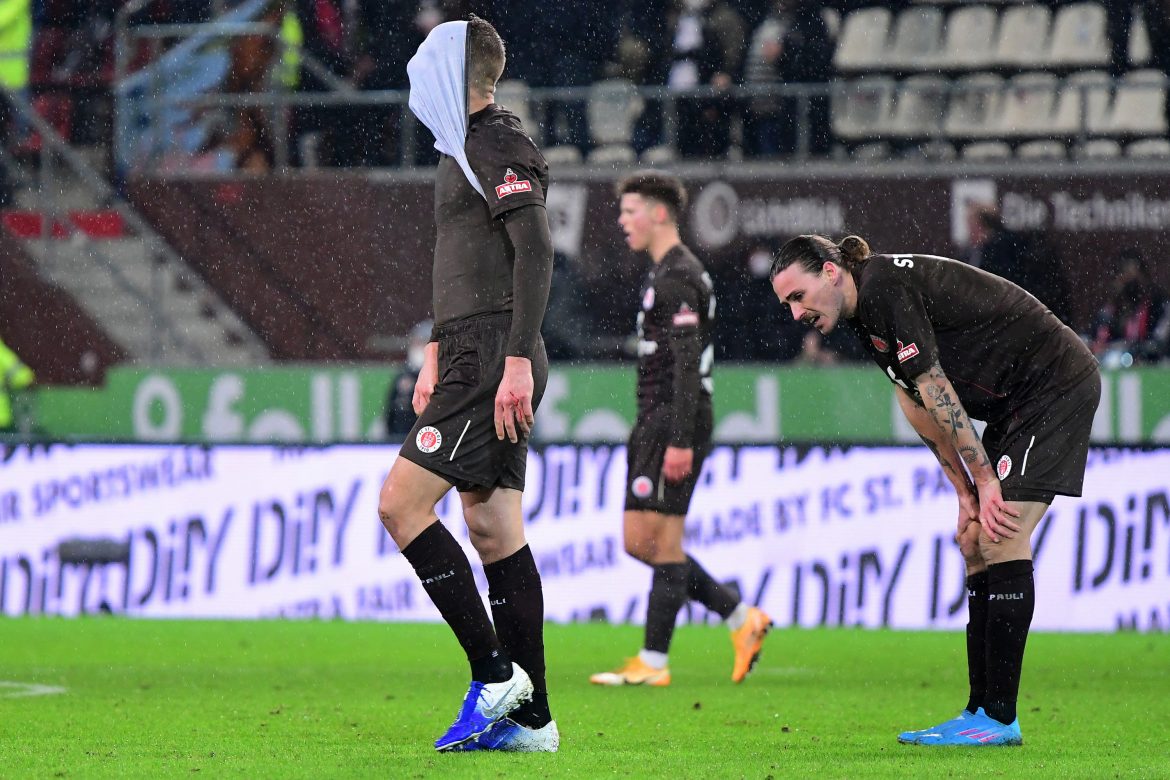

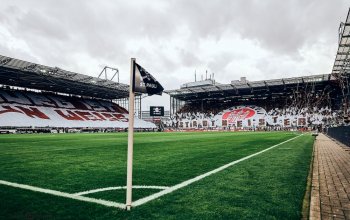

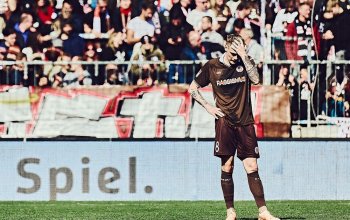
Muss uns die Aussage des Trainers nachdenklich stimmen? Droht die Rückkehr der „Wohlfühloase“?
Ich denke eher nicht. Aber die Aussagen auf der PK haben mich definitiv aufhorchen lassen. Das waren schon deutliche Worte
Für mich war erschreckend, dass so gut wie alle 2ten Bälle an Paderborn gingen….. – entweder durch ungenaue Anspiele oder auch durch unglaublich „leichtsinnige“ Ballverluste durch meiner Meinung nach unnötige 1:1 Situationen.
Die 2ten Bälle waren auch hinten das Problem – so gut wie jeder Abpraller, jede unkontrollierte Befreiungsaktion von hinten landete bei den Paderbornern. Irgendwann haben die im „TV“ mal von einer Zweikampfquote von 60% für St.Pauli gesprochen. In der zwetien Halbeit zumindest war das gefühlt eher 30:70 für die Paderborner – allerdings war bei Eroberung der 2ten Bälle oftmals gar kein Zweikampf nötig weil unsere Jungs immer viel zu weit weg waren….. 🙁
Oder ist das nur meine subjektive Meinung ?
Was mir noch aufgefallen ist: Amenyido hat 1 Tor vorbereitet und 1 selbst gemacht – eigentlich mehr als man an einem Spieltag erwarten darf, aber auf einer Mittelfeldposition darf man in der Vorwärtsbewegung nicht so einfach Bälle verlieren. Ganz vorne kann das kompensiert werden, aber in der Mittelfeldraute ganz vorne (auf der 10 ?) sind so Ballverluste oftmals tödlich – vor allem wenn die ganze Mannschaft nach vorne schiebt steht man hinten viel zu offen. Aktuell sehe ich Amenyido eher vorne drin – nicht im Mittelfeld.
Bei Irvine bin ich bei Dir, oftmals zu weit vorne – weiter hinten fehlt er als Anspielstation und bei Ballverlust als Absicherung.
Ja, die Zweikampfwerte sind etwas, was meist im Nachhinein noch korrigiert wird, wenn die Spiele für die Datenbanken nochmal überarbeitet werden. Da würde ich bei den Live-Daten immer vorsichtig sein (es sei denn der Trend ist ganz deutlich).
Amenyido ist ein klarer Stürmer. Den sehe ich auch nicht dauerhaft auf der 10. Ich denke, dass jemand wie Kyereh auf dieser Position noch sehr viel wichtiger für den Spielaufbau ist. Da ist Amenyido doch eher weniger aktiv.
Ich weiß nicht, ob ich offensivere Mittelfeldakteure immer etwas positiver einschätze als ihre Defensiv-Kollegen, aber ich fand Jackson Irvine gestern deutlich zweikampfstärker und ballsicherer als zB Eric Smith. Was sagt da die Statistik? Dafür, dass er mal wieder auf großer Länderspieltour war, hat mir seine Leistung ziemlich imponiert. Aber wie gesagt: Hab da vielleicht ne Offensiv-Brille auf.
Anderer Aspekt: Zweimal hat das Kombinieren im Strafraum extrem gut geklappt und auch zum Torerfolg geführt. Meistens war mir da aber ein Kontakt oder Pass zu viel da. Kommt mir so vor, als ob der direkte Torabschluss noch mehr gesucht werden muss. In HZ2 hab ich mich mal dabei ertappt, dass ich dreimal „Schieß“ gerufen habe, bevor überhaupt was passiert ist. Weiß gar nicht mehr, wer es war, auf jeden Fall wurde die gute Gelegenheit vorne links verdaddelt.
Eric Smith sieht nie wirklich gut aus, wenn er in Zweikämpfe auf die Außenbahn gehen muss. Wenn er das muss, bedeutet es aber auch, dass irgendwo vorher was falsch gelaufen ist. Denn Smith verlässt den Secsherraum nicht, wenn es nicht zwingend notwendig ist. Im Aufbauspiel habe ich ihn aber auch verhältnismäßig unsicher erlebt.
Taktik und Spielformation hin oder her, ich finde gestern hat man wieder deutlich den Unterschied zwischen FCSP mit und ohne Daniel-Kofi Kyereh -in Topform- gesehen.
Schlüsselspieler… wer beispielsweise den BVB samstags vor dem Pokal mit Mo Dahoud in der Liga gesehen hat, und danach ohne ihn am Millerntor…
Ja, das fiel schon ziemlich doll auf, dass Kyereh fehlte. Ich hatte gehofft, dass das Team diesen Verlust besser abfedern könnte.